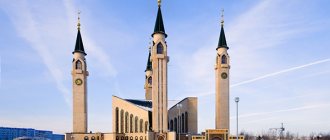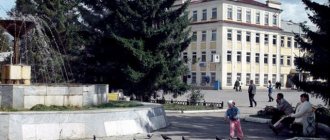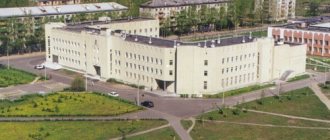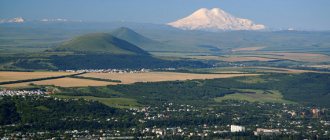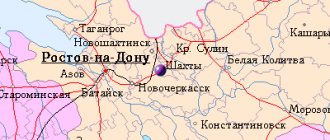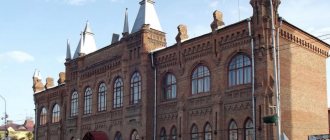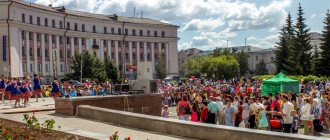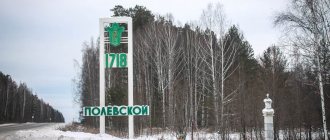Slavyansk-on-Kuban
The magnificent, flourishing city of Slavyansk-on-Kuban with a total area of more than 4 thousand hectares and a population of over sixty-four thousand people, today is a regional center, a significant unit in the development of Kuban. It stands on important transport arteries; roads to the ports of Novorossiysk, Temryuk, the port of Kavkaz pass through it, and the city is crossed by a railway line.
Modern Slavyansk-on-Kuban is a hard-working city. A city of oil workers and rice farmers, gardeners and builders, workers in processing industries and entrepreneurs. The city can rightly be called a student city. The Slavyansk-on-Kuban State Pedagogical Institute has been operating for more than ten years, and the Slavyansk Agricultural College has been producing qualified specialists for about 80 years. Medium and large businesses are widely developed in the city; there are more than 1,500 enterprises and more than 3,000 entrepreneurs. Successful, large enterprises contribute to the development of the city, in particular, Neftegaztenology-Energy OJSC, Cementnaya Transportnaya LLC, Slavyansky Bakery CJSC, Slavyanskaya Road Mobile Mechanized Column CJSC, Slavyansk Passenger Motor Transport Enterprise LLC, Maslosyr OJSC, OJSC "Kubrisvodstroy", CJSC Slavyansky, LLC "Gorvodokanal", OJSC Garment Factory "Slavyanskaya".
The city attracts people from all over the country with its climate, recreational conditions and hospitality of its residents; it delights the eye with wide and straight streets, magnificent squares, an abundance of flowers and greenery, new buildings in residential areas and architectural buildings of the last century.
A network of cultural institutions has been created in the city: a local history museum, an art gallery, a nature museum of the Azov region, children's art schools, interest clubs, an art school, a library system and a cinema network. The city is proud of its artistic groups: the pop symphony orchestra, the choreographic ensemble “Rhythms of the Planet”, the sacred music choir, the violin ensemble “Cantabile”, the male Cossack ensemble “Nugget”, VIA “Chance” and others. He is also proud of world-class athletes, such as Evgeniy Lukyanenko, world champion in athletics, Sergei Vodopyanov, world champion in boxing.
A network of healthcare institutions is actively developing in the city. Streets are being built, houses, shopping and entertainment complexes are being built. Many generations of Slavs lived and worked on this land, decorating it with their labors. And today, continuing the tradition of our ancestors, we are improving and greening our beautiful city.
In 2006, the Heraldic Commission under the President of the Russian Federation approved the coat of arms of the city of Slavyansk-on-Kuban, and in 2007 - the flag.
Climate of the Slavyansky region
The Slavic region is located within the climatic province of the Azov-Kuban Plain, which is part of the climatic region of the Northern slope of the Greater Caucasus and the plains of the Ciscaucasia.
This territory is exposed to polar and Atlantic air masses.
The climate of the region is temperate continental. The main factor determining the peculiarity of the climate is the proximity of the Azov and Black Seas, which significantly soften the continentality, giving the climate a moderately warm character.
Air temperature in the summer months is characterized by the most constant variation. In winter, there are significant fluctuations in daily and monthly temperatures. The lowest temperatures are observed in January-February, the maximum is in July-August.
The average annual air temperature is + 10.6 0C, with an increasing trend in recent years.
Winter in this area is moderately mild, beginning in the second ten days of December and lasting 6-9 weeks, accompanied by frequent changes in air temperature above 0 °C, which causes intense thaws. The average monthly temperature in January is minus 2.6 °C. The snow cover is low, unstable and almost absent in the first half of winter. The depth of soil freezing is 0.8 m.
The transition from winter to spring is characterized by an unstable weather regime with frequent warming and cold snaps. The duration of the frost-free period is 189 days.
Summer begins in mid-May, is moderately hot, accompanied by precipitation in the form of rain showers. The average monthly temperature in July is +23 oC.
Autumn is long, characterized by warm, sunny weather, and usually begins in early October. The first frosts usually occur in mid-October, the last in mid-April.
Cooling of the air at night leads to the formation of fog. The most foggy days occur from November to March (30 days). The total number of days with fogs reaches 40.
The area belongs to the moderate moisture zone. Throughout the year, the amount of precipitation is distributed fairly evenly across months (the summer maximum is slightly prominent). The average annual precipitation is 560 mm.
Air humidity has a clearly defined annual cycle, similar to changes in air temperature. Relative humidity within the study area is quite high and ranges from 60-80%.
The wind rose is constant. In winter, northeast winds predominate, in summer – southwest. Average wind speed is 2.4 m/s. The average number of days with strong winds (more than 15 m/s) is 19, the highest speeds (18-20 m/s) are typical for winds from eastern directions.
Sochi is a densely populated resort
Sochi is a fairly young city: active settlement began only in the second half of the 19th century. Thanks to this, the bulk of the residents are visitors not only from other territories of the region, but also from all over Russia and the countries of the post-Soviet space.
In total, Greater Sochi has 507 thousand 365 inhabitants, the density is 127 people/m2. However, they are distributed extremely unevenly across regions:
- Central (smallest) - 166.06 thousand.
- Adlersky - 149.3 thousand.
- Lazarevsky - 94.5 thousand.
- Khostinsky - 92.8 thousand.
Thanks to the prestige of the resort, the population has been growing steadily since the eighties of the last century. And even the slight decline in 2002 was more than compensated for by the interest in Sochi during the Olympics. In 2010, the number of residents was 420,589, in 2016 - 480,000, and over the past two years it has increased by almost 30,000, which is a significant increase for a city with a population of up to a million.
The ethnic composition of the region is very diverse, since it was previously inhabited by numerous peoples of the Caucasus, as well as visitors from other states. Today, the main part is made up of Russians and Armenians with shares of 69.92% and 20.09% of the total population. Also in the top ten predominant nationalities are Ukrainians, Georgians, Circassians, Greeks, Tatars, Belarusians, Abkhazians, Ossetians.
Current data
The territory of the region is home to 5,675,462 people. It is considered the only region where the population exceeded the 10% threshold after the collapse of the Soviet Union. The city is known for its fertile soil and hardworking population. Residents of the northern regions stay in the city, they come from the Far East of the country, Siberia, central Russia, CIS countries (especially from Ukraine) since in spring and summer fruit trees and berries grow on every corner of their home plots; more than 10 cities are considered resort cities and invite you to relax on the coast of the Black or Azov Sea.
In the Krasnodar region there are large areas of abandoned territories. The region ranks third in population density after Moscow. More than 100 different nationalities live, this does not prevent the Kuban people from remaining welcoming and friendly. Residents of provincial cities support agriculture, since the salary level is low.
Novorossiysk is the largest port city
Novorossiysk, located on the Black Sea coast, plays a vital role in the state’s economy, since it is home to the country’s largest seaport, which accounts for 55% of the cargo turnover of the Azov-Black Sea basin. In this regard, there are always jobs with stable wages, which attracts residents of small surrounding settlements.
The population of Novorossiysk is steadily increasing:
- 1853 - 960;
- 1906 - 43,000;
- 1959 - 93,461;
- 2000 - 203,300;
- 2018 - 334,506.
According to the migration service, the actual figure is even higher: 420,000 people at the beginning of 2021. The increase is due to the birth rate and migration: only the official number of visitors in 2021 was 6.5 thousand, the real level may be higher. The overwhelming majority in terms of national self-identification are Russians - 88.01%. Armenians follow by a large margin: their share is 3.37%. Ukrainians, Tatars and Greeks were also recorded in Novorossiysk.
Marriages and divorces
Based on official data, it has been established that marriages are registered more often than divorces. The number of divorces exceeds the normative level by 70%; last year, 715 divorces per 1,000 marriages were calculated. The gloomy picture is due to starvation wages and insufficient jobs. In provincial cities with a population of less than 100,000 people, there are no vacancies in budgetary organizations, because now pensioners whose retirement age has been extended work there.
The real figure for the average salary is 18,000 rubles, which differs significantly from the official data, which are advertised daily in the news feed and repeatedly duplicated on television channels by the administration of the Krasnodar Territory. Minimum income and lack of jobs cause family breakdown.
Forecast
The forecast for Kuban is favorable, despite the fact that the capital Krasnodar is located on a thin platform of the earth's surface, under which an underground sea flows. Therefore, soil corrosion and the construction of multi-story buildings are extremely undesirable. Unfortunately, young people and guests of Krasnodar are attracted only by the capital of Kuban, since only here the infrastructure is developed, there are medical centers, scientific organizations, hypermarkets, and large complexes selling comfort goods.
There are many abandoned villages, desert areas, and closed factories in the Kuban. According to official data, about 400 people per 100,000 healthy population suffer from cancer. This terrible figure is associated with environmental pollution, the release of carbon dioxide and petroleum products into the atmosphere, rivers, and clean ponds. Malignant cancer has become the scourge of the younger generation. The disease affects people of working age and children, less often pensioners.
It is worth noting that only in Krasnodar residents have an average salary of 20,000 -35,000 rubles. In provincial cities, workers are deprived of this opportunity, and the average salary is 18,000 rubles, moreover, the cost of food and utility tariffs are rising uncontrollably. Almost every Kuban resident has a plot where they can plant vegetables and fruits and fruit trees.
The intellectual industry is well developed; there are more than 100 universities, schools, colleges, and institutes of various fields. The mentality of Kuban residents is for the most part “farmer”, but friendly; you will rarely meet a timid and notorious native resident on the street. Kuban bread, butter and flour are distributed for sale to the eastern and central parts of the country by rail.
H2 – Statistics by year
The Krasnodar region is famous for its warm temperate climate. Population statistics increase by several percent every year. In 2014 – 5404.3, 2015 – 5453.3, 2016 – 5513.8, 2017 – 5570.9, 2021 – 5648.3 people. The increase began in 1998. The population of the city is 5,675,462 people, of which 3,141,509 are in urban settlements and 2,533,953 in rural settlements. The rapid growth rate is concentrated in the big city, so few people want to stay in villages.
Migration
Every year hundreds to thousands of people migrate to the Krasnodar region from the northern part and central Russia. Hoping to get a better and easier life. True, the land on the territory is fertile; cherry plums and apples, plums and pears grow at every step. Residents of Georgia, Abkhazia, and Ossetia also migrate to the Krasnodar Territory. Population growth during the period of an imaginary coronavirus infection stopped due to a ban on exit and entry.
From January to April, 21,900 people managed to move into the Krasnodar Territory. More than half came from the CIS countries (Ukrainians). The indigenous population mainly moves to Greece, Abkhazia and Germany. Kuban is a production center for growing wheat.
Gender and age
The life expectancy of the average Kuban resident in the Krasnodar region ranges from 50 to 70 years. Official information as of January 1, 2020: the number of men – 2617935, women – 3030300, total – 5648235. From the listed parameters we can conclude that there are several times fewer men than women. The urban population is 3,116,443, of which 1,417,995 are men and 1,698,450 are women. Rural settlement - 2531790, of which 1199940 are men, 1331850 are women.
